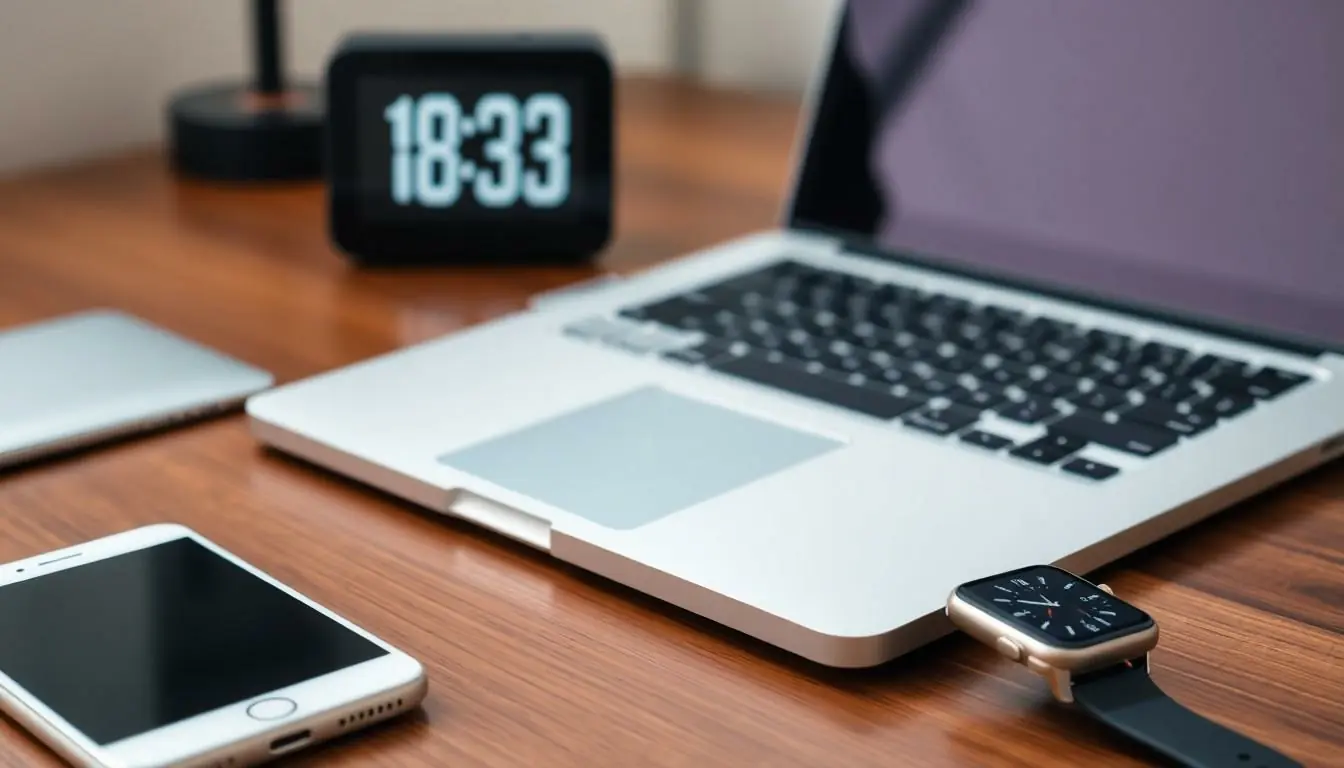Table of Contents
ToggleEver found yourself staring at a standby clock that seems to have a mind of its own? You’re not alone. Many people struggle with these quirky devices that often refuse to cooperate. Whether it’s displaying the wrong time or just being plain annoying, a malfunctioning clock can throw off your entire day.
Understanding Standby Clocks
Standby clocks play a crucial role in keeping accurate time when devices are inactive. Familiarizing oneself with their functionality enhances overall user experience.
What Is a Standby Clock?
A standby clock is a timekeeping mechanism within electronic devices that remains active while the device is powered down. This clock typically ensures the accurate display of time even when the main functions are not in use. Devices like televisions, computers, and appliances integrate standby clocks to maintain time settings and often support features like alarms and timers. Accuracy of a standby clock remains essential for consistent timekeeping across various applications.
Importance of Adjusting Your Standby Clock
Adjusting the standby clock ensures the accurate display of time and prevents discrepancies in scheduled tasks. An uncalibrated clock may lead to missed appointments or disrupted routines. Users rely on these clocks for precision in daily scheduling, which fosters a sense of reliability. Inconsistent timekeeping negatively impacts the functionality of devices, creating confusion. Regularly setting the standby clock helps maintain sync with the actual time, guaranteeing that users can trust their devices for timely alerts.
Different Devices with Standby Clocks


Standby clocks appear in various devices, each with unique functionalities. These clocks maintain accurate time, even during power-saving modes or when the device is inactive.
Standby Clocks in Smartphones
Smartphones integrate standby clocks to ensure users receive timely notifications. When a phone enters sleep mode, the clock continues to run, helping users manage calls and alerts without checking the screen. Adjusting the standby clock involves navigating to the settings menu, typically found under the date and time section. Some smartphones sync automatically with network time, minimizing discrepancies. Heeding these settings enhances the overall user experience and ensures the clock stays accurate.
Standby Clocks in Laptops
Laptops utilize standby clocks to preserve timekeeping during sleep or hibernation modes. These clocks keep the system clock running accurately, ensuring seamless transitions when waking the device. Users can modify the standby clock settings through the operating system’s date and time settings. Many laptops offer options for synchronization with internet time servers, reducing manual adjustments. Making these adjustments contributes to improved productivity and time management.
Standby Clocks in Smartwatches
Smartwatches depend on standby clocks to ensure users maintain awareness of notifications and health metrics. Even when powered down or in low-energy modes, the clock continues to track time reliably. Users typically adjust settings through the smartwatch app or directly on the device. Some models automatically synchronize with their paired smartphones, providing continuous accuracy. Regularly checking these settings promotes a dependable timekeeping experience.
How to Change Standby Clock
Adjusting the standby clock on various devices ensures accurate timekeeping. Below are step-by-step guides for smartphones, laptops, and smartwatches.
Step-by-Step Guide for Smartphones
To change the standby clock on a smartphone, start by navigating to the Settings app. Tap on “Date & Time.” Enable the “Automatic Date & Time” option for synchronization. If preferred, users can manually set the date and time. After adjustments, verify that the correct time displays on the lock screen. Exit the settings to return to normal functionality.
Step-by-Step Guide for Laptops
Accessing the standby clock on a laptop requires opening the Control Panel. Select “Clock and Region,” then click on “Date and Time.” Here, users can choose “Change time zone” to adjust settings for accuracy. After making changes, hit “OK” to save. It’s beneficial to synchronize the clock with an internet time server for the most precise results.
Step-by-Step Guide for Smartwatches
To adjust the standby clock on a smartwatch, swipe down on the home screen. Tap the settings icon, then navigate to “Time.” Users can select “Automatic Time Zone” for real-time updates. Alternatively, manually setting the time provides flexibility. Confirm the changes to ensure time accuracy during monitoring of health metrics.
Common Issues When Changing Standby Clocks
Adjusting standby clocks can lead to several common issues. Users often encounter problems like incorrect time display, difficulty accessing settings, or failed synchronization with network time servers. Each of these challenges can disrupt daily routines and create frustration.
Troubleshooting Tips
Start by checking that the device is connected to the internet. A stable connection often ensures better synchronization with time servers. Updating the operating system can also resolve glitches affecting time settings. Restarting the device may help reset any minor software issues. Ensure that all time zone settings align with the user’s location to avoid confusion. If adjustments don’t take effect, clear the cache or reset the device’s clock settings to factory defaults.
When to Seek Professional Help
Consider consulting a technician if the standby clock remains unresponsive despite troubleshooting efforts. Persistent issues after updates might indicate deeper software malfunctions. For hardware-related concerns, such as internal clock components malfunctioning, professional assistance will ensure accurate diagnosis. Users should also seek help if there are persistent discrepancies in timekeeping that could affect scheduled events. Trusting a professional can prevent further complications and ensure reliable performance.




